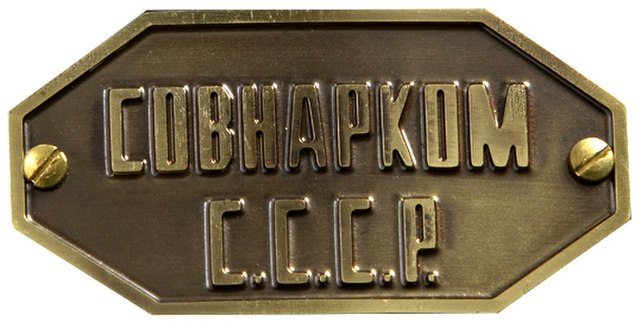Ministry of Justice (Soviet Union)
The Ministry of Justice of the Union of Soviet Socialist Republics (USSR), formed on 15 March 1946, was one of the most important government offices in the Soviet Union. It was formerly known as the People's Commissariat for Justice abbreviated as Наркомюст (Narkomiust). The Ministry, at the All-Union (USSR-wide) level, was established on 6 July 1923, after the signing of the Treaty on the Creation of the USSR, and was in turn based upon the People's Commissariat for Justice of the Russian Soviet Federative Socialist Republic (RSFSR) formed in 1917. The Ministry was led by the Minister of Justice, prior to 1946 a Commissar, who was nominated by the Chairman of the Council of Ministers and confirmed by the Presidium of the Supreme Soviet, and was a member of the Council of Ministers.

List of persons to be tried by the Military Collegium of the Supreme Court. Approving signatures: Joseph Stalin, Kliment Voroshilov, Lazar Kaganovich, Andrei Zhdanov, and Vyacheslav Molotov. The first page of a typical trial (de facto execution) list from the time of the Great Purge
Nikolai Krylenko was the first People's Commissar for Justice of the USSR
Government of the Soviet Union
The Government of the Union of Soviet Socialist Republics (USSR) was the executive and administrative organ of the highest body of state authority, the All-Union Supreme Soviet. It was formed on 30 December 1922 and abolished on 26 December 1991. The government was headed by a chairman, most commonly referred to as the premier of the Soviet Union, and several deputy chairmen throughout its existence. The Communist Party of the Soviet Union (CPSU), as "The leading and guiding force of Soviet society and the nucleus of its political system" per Article 6 of the state constitution, controlled the government by holding a two-thirds majority in the All-Union Supreme Soviet. The government underwent several name changes throughout its history, and was known as the Council of People's Commissars from 1922 to 1946, the Council of Ministers from 1946 to 1991, the Cabinet of Ministers from January to August 1991 and the Committee on the Operational Management of the National Economy from August to December 1991.

A governmental badge from 1930.
The composition of Stalin's Second Government as shown in 1946.
Alexei Kosygin was the longest-serving chairman of the Soviet government, holding office from 1964 until his death in 1980.
Gorbachev at the 1st Plenary Session of the I Congress of People's Deputies in 1989.






